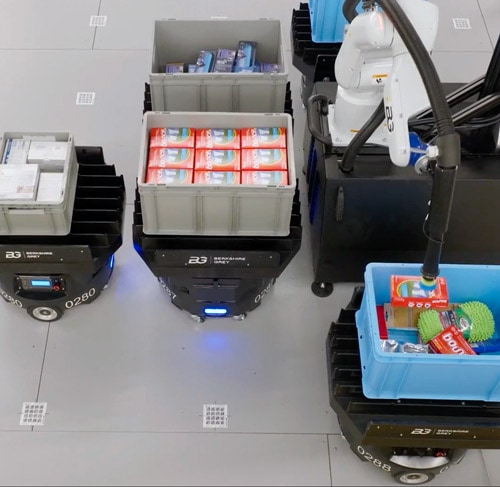What is Robotic Automation?
In the past few decades, robotic automation technology has seen explosive growth—evolving from a fringe technology used in very specific applications to a mandatory component of staying competitive and financially viable for distribution warehouses and fulfillment centers. This adoption trend has only accelerated in the past five years as labor shortages, supply chain challenges, and the continued dominance of eCommerce has stretched traditional fulfillment practices past their limits.
In simple terms, robotic automation is taking tasks that were traditionally completed manually—such as order picking—and converting them into an automatic process conducted by a robot. When most people think of robotic automation, they probably think of robotic arms operating next to a conveyor belt, but robotic automation can go far beyond this. Today, mobile robots can autonomously navigate warehouses with little to no human supervision by leveraging robotic artificial intelligence to adapt to their surroundings and make independent decisions.
How Does Robotic Automation Help Fulfillment Operations?

Robotic automation has quickly gone from a nice-to-have to a requirement for the success of fulfillment operations. Traditional methods of picking, packing, sorting, and processing items through manual labor are no longer able to keep up with the demands of consumers. In addition to being tedious and slow, manual work is also prohibitively expensive for most fulfillment or distribution operations.
Robotic automation can help fulfillment operations in several key areas:
- Greatly expanded throughput. By using robots to automate functions like sortation systems, businesses can vastly improve the number of items they process. Rather than having a human manually process returns—a costly and time-intensive process—robots can autonomously presort returned packages.
- Reduced labor costs. As labor costs continue to rise, the accessibility of robotic automation continues to increase. Robotic automation offers excellent ROI, especially when it comes to automating repetitive, dangerous, or simple tasks.
- Smaller operational footprint. Robots can function effectively in tight spaces that would be unsafe for people to work in. Automation solutions can also make better use of vertical space and do not require as much empty space to be safe.
- Easy scalability. Scalability is a significant concern for any fulfillment warehouse or distribution center. Order volumes can increase exponentially during peak season, overwhelming existing systems. By contrast, robotic automation systems are much easier to scale to meet demand. Need more order picking capacity? Add additional mobile picking robots to your fleet!

The Berkshire Grey Solution
Berkshire Grey offers a complete portfolio of automation solutions to meet the needs of supply chain and logistics enterprises across a variety of industries like eCommerce, retail, grocery, and third-party logistics (3PL).
Automated Picking and Packing
Complex sortation through AI-enabled robotics
Robotic Automation with Berkshire Grey
Complete automation in a modular package
Berkshire Grey’s solution portfolio seamlessly integrates with traditional fulfillment and distribution operations so you can automate at the level your business needs. Customers can incrementally add or change solutions with the option to incorporate outside technologies if desired. Whatever your requirements, Berkshire Grey’s team is prepared to support you.
Full-service support
Work with Berkshire Grey’s team of experts and get support for installation, testing, commissioning, and technical support to make the most of your robotic automation solution. Taking the leap into an automated warehouse system can be intimidating, and Berkshire Grey will be by your side each step of the way.
Accessible software
All of Berkshire Grey’s robotic automation solutions are integrated into a web-based management dashboard to track performance and work progress. Track metrics like picks-per-hour or order completion time in real-time on desktop, or mobile. BG’s software and automation systems also integrate with your existing IT infrastructure to make implementation as seamless as possible.
Why Clients Choose Berkshire Grey
Flexible investment options
Berkshire Grey’s team works with every client to determine what investment model works best for them. Berkshire Grey’s approach to Robotics-as-a-Service (RaaS) is uniquely transparent and applies to our catalog of robotic automation solutions. BG RaaS comes with no extra usage or maintenance fees. Businesses can also choose hybrid pricing options which mix CapEx and RaaS pricing models.
Performance for the real‑world
Each of Berkshire Grey’s robotic automation solutions has been stress-tested in a variety of real-world scenarios to ensure reliability in mission-critical applications. Enterprise-grade performance is a requirement for all of Berkshire Grey’s offerings.
FAQs
A robotic warehouse is a warehouse that primarily uses automation systems such as robots to complete tasks without manual labor.
AI is becoming an increasingly important part of warehouse automation. AI enables robots to work autonomously in complex, open environments and make independent decisions based on environmental inputs with no operator intervention.
Get Started
with Berkshire Grey
Contact the BG Fulfillment Automation Sales Engineering Team to Learn How to:
- Reduce operations expense by up to 70%.
- Lessen your dependency on labor.
- Bolster facility throughput by up to 25% to 50% with automation.
- Get a customized ROI analysis of your specific environment and business.
Call +1 (833) 848-9900 or connect using our form.
